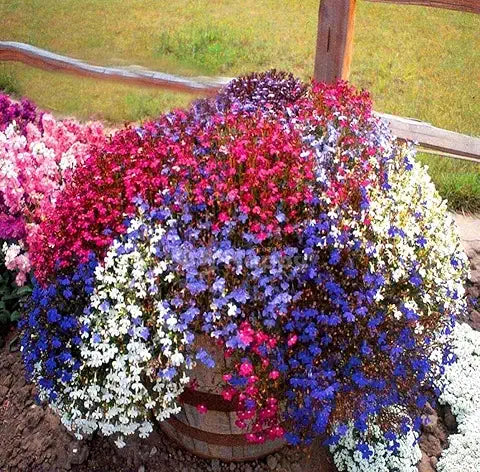Lobelia Flower Easy Grow Plant Seeds
Couldn't load pickup availability
Description
Lobelia Seeds
Characteristics and Uses of Lobelia Plants
Lobelia plants are known for their vibrant, cascading flowers in shades of blue, purple, pink, and white. These stunning plants are often used to add color to hanging baskets, window boxes, and containers, creating a beautiful display of blooms. Their trailing habit makes them an excellent choice for adding depth and texture to flower beds and borders. Lobelia seeds are perfect for gardeners who want to grow attractive, low-maintenance plants that thrive in both sunny and partially shaded environments. The plants also attract pollinators like bees and butterflies, enhancing the overall health of your garden.
Growing Conditions for Lobelia Plants
- Light Requirements: Lobelia thrives in full sun to partial shade, with the best results achieved when it receives at least 4-6 hours of sunlight each day.
- Temperature: These plants prefer cool to moderate temperatures, ideally between 60°F and 75°F (15°C - 24°C), and can tolerate light frosts.
- Soil: Lobelia prefers well-drained, moist, and slightly acidic to neutral soil (pH 6.0-7.0).
- Humidity: Moderate humidity levels are ideal for Lobelia. Ensure the plants are watered regularly to maintain soil moisture but avoid waterlogging.
Planting Tips for Lobelia
- Seed Preparation: Lobelia seeds are small, so be sure to handle them carefully. Lightly press them into the soil without covering them, as they need light to germinate.
- Planting Depth: Seeds should be sown on the surface of the soil or lightly pressed in, without covering them, as they need light to trigger germination.
- Spacing: Space Lobelia plants about 6-12 inches apart to allow for their natural spreading habit.
- Germination Time: Lobelia seeds typically germinate within 10-1days when kept in a warm and moist environment.
Watering Instructions and Tips
Lobelia plants require consistent moisture, especially during their early stages of growth. Water them regularly to keep the soil moist, but avoid letting them sit in waterlogged conditions. Use well-draining soil to help prevent root rot. Once established, Lobelia is somewhat drought-tolerant but benefits from occasional watering during hot, dry spells.
Growing Zones
- USDA Hardiness Zones: Lobelia plants are typically suited for USDA Zones 2-, making them versatile in many different climates.
- Global Zones: Lobelia thrives in temperate regions and can be grown in both cool and warm climates with proper care.
Key Benefits & Uses
- Non-GMO seeds: All Lobelia seeds are non-GMO, allowing you to grow pure, natural plants in your garden.
- Attractive Foliage and Flowers: The trailing vines and colorful blooms make Lobelia a popular choice for decorative containers and hanging baskets.
- Pollinator-Friendly: Lobelia attracts beneficial insects like bees and butterflies, supporting the health of your garden ecosystem.
- Low Maintenance: Once established, Lobelia is relatively easy to care for, making it a perfect choice for both novice and experienced gardeners.
Best Uses in the Garden & Landscape
- Hanging Baskets: The cascading growth habit of Lobelia makes it perfect for hanging baskets, adding vibrant color to patios and balconies.
- Container Gardens: Lobelia can be grown in containers and pots, either alone or as part of a mixed planting for a colorful display.
- Border Plants: Plant Lobelia along garden borders to create a colorful, trailing effect that contrasts well with other flowers.
Conclusion
Lobelia plants are an excellent choice for gardeners looking to add vibrant color and texture to their landscapes. With their easy-care nature and ability to attract pollinators, these plants are ideal for both beginners and seasoned gardeners. At bijaseeds, a big, trusted name in the seed world, we offer high-quality, non-GMO Lobelia seeds that can bring your garden to life with beautiful, cascading flowers.
FAQ
How do I grow Lobelia from seeds?
To grow Lobelia from seeds, sow them on the surface of moist, well-draining soil. Press them gently into the soil, but do not cover them, as they need light to germinate. Keep the seeds warm and moist until they sprout, typically within 10-1days.
When is the best time to plant Lobelia seeds?
The best time to plant Lobelia seeds is in early spring, 6-8 weeks before the last expected frost. You can start them indoors or sow them directly outdoors once the risk of frost has passed.
How often should I water Lobelia plants?
Lobelia plants need consistent moisture. Water them regularly to keep the soil moist, but avoid overwatering, as standing water can lead to root rot. Once established, they are somewhat drought-tolerant, but regular watering helps them thrive.







